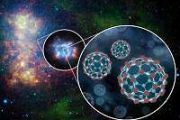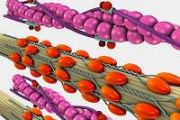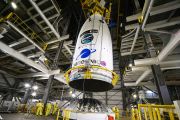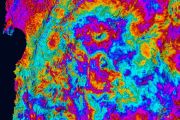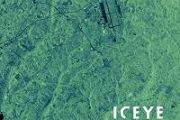
Copernical Team
Bird brains left other dinosaurs behind
 Today, being "birdbrained" means forgetting where you left your keys or wallet. But 66 million years ago, it may have meant the difference between life and death - and may help explain why birds are the only dinosaurs left on Earth.
Research on a newly discovered bird fossil led by The University of Texas at Austin found that a unique brain shape may be why the ancestors of living birds su
Today, being "birdbrained" means forgetting where you left your keys or wallet. But 66 million years ago, it may have meant the difference between life and death - and may help explain why birds are the only dinosaurs left on Earth.
Research on a newly discovered bird fossil led by The University of Texas at Austin found that a unique brain shape may be why the ancestors of living birds su A long day for microbes, and the rise of oxygen on Earth
 Virtually all oxygen on Earth was and is produced by photosynthesis, which was invented by tiny organisms, the cyanobacteria, when our planet was still a rather uninhabitable place. Cyanobacteria evolved more than 2.4 billion years ago, but Earth only slowly transformed to the oxygen-rich planet we know today.
"We do not fully understand why it took so long and what factors controlled Eart
Virtually all oxygen on Earth was and is produced by photosynthesis, which was invented by tiny organisms, the cyanobacteria, when our planet was still a rather uninhabitable place. Cyanobacteria evolved more than 2.4 billion years ago, but Earth only slowly transformed to the oxygen-rich planet we know today.
"We do not fully understand why it took so long and what factors controlled Eart Trapped saltwater caused mangrove death after Hurricane Irma
 When Hurricane Irma hit southern Florida in September of 2017, the storm buffeted coastal mangrove forests with winds over 116 mph - strong enough to rip off leaves, break branches, and snap tree trunks in half. Of the mangrove forest damaged by Hurricane Irma, about 83% recovered after the first year. But the rest didn't, leaving scientists wondering why some trees didn't bounce back.
Usi
When Hurricane Irma hit southern Florida in September of 2017, the storm buffeted coastal mangrove forests with winds over 116 mph - strong enough to rip off leaves, break branches, and snap tree trunks in half. Of the mangrove forest damaged by Hurricane Irma, about 83% recovered after the first year. But the rest didn't, leaving scientists wondering why some trees didn't bounce back.
Usi NASA satellites help plan future for Palau fish stocks
 It's the weekend, and freshly caught fish sizzles on the grill. The view: an unforgettable beach and the cobalt blues of the Pacific Ocean in the backdrop.
This is not paradise. It's a typical Sunday for many people in Palau, an archipelago nation in Micronesia.
"We would go to the Rock Islands, spend a couple of nights there, and we would go fishing," recalled Fabio Siksei, a fisher
It's the weekend, and freshly caught fish sizzles on the grill. The view: an unforgettable beach and the cobalt blues of the Pacific Ocean in the backdrop.
This is not paradise. It's a typical Sunday for many people in Palau, an archipelago nation in Micronesia.
"We would go to the Rock Islands, spend a couple of nights there, and we would go fishing," recalled Fabio Siksei, a fisher Experiment bound for Space Station turns down the heat
 A lot of power means a lot of heat. NASA's future missions to explore the Moon and Mars will require enormous amounts of electrical power and hardware to support astronauts and drive new technologies. This increase in power, however, also increases the amount of heat generated-and then that heat needs to be removed so all the spacecraft systems can function.
To remove heat efficiently and
A lot of power means a lot of heat. NASA's future missions to explore the Moon and Mars will require enormous amounts of electrical power and hardware to support astronauts and drive new technologies. This increase in power, however, also increases the amount of heat generated-and then that heat needs to be removed so all the spacecraft systems can function.
To remove heat efficiently and NASA launches x-ray spectrometer mission to probe mysteries of solar corona
 NASA researchers successfully launched a sophisticated X-ray solar imager on a brief but potentially illuminating suborbital flight via sounding rocket to gather new insight regarding how and why the Sun's corona grows so much hotter than the actual surface of Earth's parent star.
Developers at NASA's Marshall Space Flight Center in Huntsville, Alabama, call the mission "MaGIXS" - short fo
NASA researchers successfully launched a sophisticated X-ray solar imager on a brief but potentially illuminating suborbital flight via sounding rocket to gather new insight regarding how and why the Sun's corona grows so much hotter than the actual surface of Earth's parent star.
Developers at NASA's Marshall Space Flight Center in Huntsville, Alabama, call the mission "MaGIXS" - short fo Juno joins Japan's Hisaki satellite and Keck Observatory to solve "energy crisis" on Jupiter
 Sitting more than five times the distance from the Sun as Earth, Jupiter is not expected to be particularly warm. Based on the amount of sunlight received, the average temperature in the planet's upper atmosphere should be about minus 100 degrees Fahrenheit or a chilly minus 73 Celsius. Instead, the measured value soars to around 800 degrees Fahrenheit or 426 Celsius. The source of this extra he
Sitting more than five times the distance from the Sun as Earth, Jupiter is not expected to be particularly warm. Based on the amount of sunlight received, the average temperature in the planet's upper atmosphere should be about minus 100 degrees Fahrenheit or a chilly minus 73 Celsius. Instead, the measured value soars to around 800 degrees Fahrenheit or 426 Celsius. The source of this extra he North-By-Northwest for Ingenuity's 11th Flight
 We're heading northwest for the 11th flight of NASA's Ingenuity Mars Helicopter, which will happen no earlier than Wednesday night, Aug. 4. The mission profile is designed to stay ahead of the rover - supporting its future science goals in the "South Seitah" region, where it will be able to gather aerial imagery in support of future Perseverance Mars rover surface operations in the area.
H
We're heading northwest for the 11th flight of NASA's Ingenuity Mars Helicopter, which will happen no earlier than Wednesday night, Aug. 4. The mission profile is designed to stay ahead of the rover - supporting its future science goals in the "South Seitah" region, where it will be able to gather aerial imagery in support of future Perseverance Mars rover surface operations in the area.
H Helicopter scouts ridge area for Perseverance
 Ask any space explorer, and they'll have a favorite photo or two from their mission. For Kevin Hand, a scientist at NASA's Jet Propulsion Laboratory in Southern California and co-lead of the Perseverance rover's first science campaign, his latest favorite is a 3D image of low-lying wrinkles in the surface of Jezero Crater. The science team calls this area "Raised Ridges." NASA's Ingenuity Mars H
Ask any space explorer, and they'll have a favorite photo or two from their mission. For Kevin Hand, a scientist at NASA's Jet Propulsion Laboratory in Southern California and co-lead of the Perseverance rover's first science campaign, his latest favorite is a 3D image of low-lying wrinkles in the surface of Jezero Crater. The science team calls this area "Raised Ridges." NASA's Ingenuity Mars H Satellites reveal how forests increase cloud and cool climate

Forests are not only key to moderating our climate by sequestering atmospheric carbon, but they also create a cooling effect by increasing low-level cloud. A first global assessment using satellite observations has shown that for two-thirds of the world, afforestation increases low-level cloud cover, with the effect being strongest over evergreen needleleaf forest.














